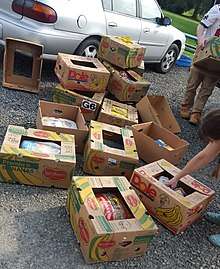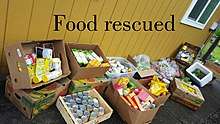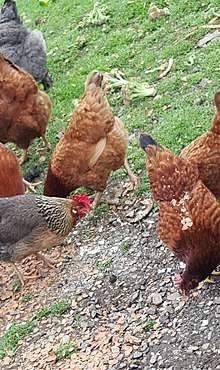Food rescue
Food rescue, also called food recovery or food salvage, is the practice of gleaning edible food that would otherwise go to waste from places such as restaurants, grocery stores, produce markets, or dining facilities and distributing it to local emergency food programs.

The recovered food is edible, but often not sellable. Products that are at or past their "sell by" dates or are imperfect in any way such as a bruised apple or day-old bread are donated by grocery stores, food vendors, restaurants, and farmers markets. Other times, the food is unblemished, but restaurants may have made or ordered too much or may have good pieces of food (such as scraps of fish or meat) that are byproducts of the process of preparing foods to cook and serve. Also, food manufacturers may donate products that marginally fail quality control, or that have become short-dated.
Organizations that encourage food recovery, food rescue, sharing, gleaning and similar waste-avoidance schemes come under the umbrella of food banks, food pantries or soup kitchens.
Details
In most cases, the rescued food is being saved from being thrown into a dumpster and, ultimately, landfills or other garbage disposals. Food recovered on farms is kept from being plowed under. On farms, the donations often must be harvested, or gleaned, by volunteers. Also, to help rescue food that would otherwise be wasted, the USDA has expanded their Farm Storage Facility Loan Program.[1] The Farm Storage Facility Loan Program helps farmers obtain low-cost loans for more farm storage so they can protect more food from becoming waste.
In the United States, businesses that source food rescue programs have received tax benefits for their donations and have been protected from liability lawsuits by the federal Emerson Good Samaritan Food Donation Act since 1996.[2]
The benefit of many food rescue programs is they offer healthy food to those in need but who may not meet the application requirements of state food-assistance programs. Many programs also provide immediate emergency assistance, without having to wait through an application process. Food rescue organizations are less restricted by cost and availability of food, as so much edible food is thrown out and free for the taking, so eligibility requirements are generally unnecessary. This organizational model often allows food rescues to provide nutritional assistance more quickly, with more flexibility and accessibility than other types of hunger relief programs.
At the individual level, food recovery is practiced by both freegans and by dumpster divers.
Food reuse strategies
There are various ways how people and organizations can rescue food that would otherwise go to a landfill. For example, United States Environmental Protection Agency recommends the following actions [3]
Source reduction
Reduce the amount of food that is generated and potentially wasted. Individuals can for example make shopping lists so they don't buy more food than they really need. [4]
Human consumption
Organizations can donate both non-perishable and unspoiled perishable food at the end of its shelf life, e. g. to food banks, food pantries, food rescue programs, homeless shelters, and other organizations. [5][6]

Feeding animals
Many animals can eat food scraps. Some farmers, solid waste collectors and recycling centers collect discarded food. [7]

Industrial uses
Anaerobic Digestion is a conversion process that converts food waste into renewable energy. Food is separated from any packaging and broken down into a more digestible state and then it is mixed with bacteria in special oxygen free holding tanks. The bacteria work to break down the food waste converting it into methane biogas which can be used to generate electricity.
Hydrothermal Liquefaction is the process of heating food waste under high pressure, converting the food waste into an oil that can then be refined into fuel. Once the initial liquefaction is complete, the watery waste left over then goes through anaerobic digestion where the microbes break down the waste into methane and carbon dioxide biogas. This biogas can be used for heat and electricity.
It is also possible to use fats, oils, grease, and meat products for rendering and biodiesel production. [8]
Composting
Add remaining food waste to an existing compost. Composting has many benefits over general waste landfills, including reduced methane gas production and improving the quality of the soil. [9]
Countries
Australia
In Australia, OzHarvest was launched in November 2004.
Canada
Canada's Second Harvest Toronto, in operation since 1985. BC's Squamish Helping Hands Society
Israel
Food rescue charities outside of the United States include Israel's Leket Israel-The National Food Bank
New Zealand
New Zealand's first food rescue organization is Kaibosh. Operating in Wellington, it was founded in August 2008. FoodShare, provides food rescue for the city of Dunedin in the South Island of New Zealand commenced operations in March 2012. Fairfood and KiwiHarvest operate in Auckland, and other organizations work in Hamilton, Tauranga, Palmerston North, and Christchurch.
Norway
A 2015 study [10] listed 53 charitable organisations that are actively running food rescue programs in Norway. The largest donors are supermarkets (59%), followed by bakeries and other food producers. The distributors are mainly charitable organizations, mostly with a religious connection, like the Salvation Army and the Church City Mission. Most of the work is done by volunteers, without any salary. The receivers are mainly narcotic and alcohol addicts, but also include homeless, immigrants and victims of domestic violence. Most of the food is given away as prepared meals. More than one million meals are provided per year in the cities covered by the study. Other food is given away as bags of groceries.
Distribution of free food is often used as a method for charitable organizations to enter into contact with people who need help with drug abuse, psychological problems or similar. Volunteers often emphasize the importance of having spaces where users can pick up food with dignity and discretion, plus sometimes have a cup of coffee or a shower. Often, volunteers provide emotional support or help people with things unrelated to food acquisition, such as sharing work tips or helping immigrants with administrative tasks requiring knowledge of the Norwegian language.
The charities sometimes cooperate with each other by having a common food bank. This makes it easier to maintain steady supplies of diversified food to users.
Some users report that receiving free food may lead to stigmatization and thereby feelings of inferiority or social exclusion. To counter this, charities sometimes charge a low, symbolic price for the food, or offer food in exchange for participating in the work of preparing it.
Singapore
In Singapore the Foodbank Singapore is running their own Food rescue project, by collecting food excess in various places around the Islandstate.[11]
United Kingdom
Some organizations, such as Fareshare in England, work directly with food manufacturers to minimize food wastage. In 2005[12] 2,000 tonnes of food was saved from being wasted, This food was then redistributed to a community food network of 300 organizations. This food contributed to over 3.3 million meals to 12,000 disadvantaged people each day in 34 cities and towns across the UK.
USA
In America, numerous food rescue organizations pick up and deliver food in refrigerated trucks. Most are members of Feeding America, formerly America's Second Harvest. Recipient agencies serve people of low and no income. The EPA estimated that in 2015, the USA produced over 39 million tons of food waste.[13]
The Society of St. Andrew is a volunteer-based gleaning nonprofit.[14]
Some organizations, like Waste No Food, use technology to notify charities where and when excess food is available to aid in their food recovery efforts.
Other nationally recognized food rescue organizations include City Harvest, La Soupe and Philabundance.
A directory of food rescue organizations is maintained by Sustainable America.
See also
Food rescue organizations
See also
- Feeding America
- Food waste
- Freeganism
- Garbage picking
- Love Food, Hate Waste
- Pending Meal
- United States Department of Agriculture
- Upcycling
References
- "Farm Storage Facility Loan Program". USDA. Retrieved 2018-06-11.
- "Bill Emerson Good Samaritan Food Donation Act" (PDF). Retrieved 1 September 2017.
- "Food Recovery Hierarchy | Sustainable Management of Food | US EPA". Epa.gov. Retrieved 2020-04-04.
- "How to Prevent Wasted Food Through Source Reduction | Sustainable Management of Food | US EPA". Epa.gov. Retrieved 2020-04-04.
- "Reduce Wasted Food By Feeding Hungry People | Sustainable Management of Food | US EPA". Epa.gov. Retrieved 2020-04-04.
- "Donating Food | Reduce, Reuse, Recycle | US EPA". Epa.gov. Retrieved 2020-04-04.
- "Reduce Wasted Food by Feeding Animals | Sustainable Management of Food | US EPA". Epa.gov. Retrieved 2020-04-04.
- "Industrial Uses for Wasted Food | Sustainable Management of Food | US EPA". Epa.gov. Retrieved 2020-04-04.
- "Reducing the Impact of Wasted Food by Feeding the Soil and Composting | Sustainable Management of Food | US EPA". Epa.gov. Retrieved 2020-04-04.
- "Reducing food waste through direct surplus food redistribution: The Norwegian case (PDF Download Available)". ResearchGate. Retrieved 1 September 2017.
- "Food rescue project details". Retrieved 29 July 2015.
- "About FareShare". Retrieved 1 September 2017.
- EPA,OSWER,ORCR, US. "Reduce Wasted Food By Feeding Hungry People | US EPA". US EPA. Retrieved 2018-05-15.CS1 maint: multiple names: authors list (link)
- "Society of St. Andrew". EndHunger. Retrieved 1 September 2017.